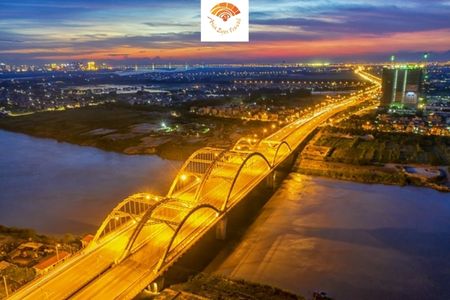Nhat Tan Bridge
Nhat Tan Bridge, also known as the Vietnam – Japan Friendship Bridge, was inaugurated in January 2015.
It is the first cable-stayed bridge in Hanoi with a total length of 8.9km (5.5 miles) with five spans, representing the capital city’s five ancient gates, crossing the Red River.
The project had total investment of VND13,600 billion ($598 million), split between the Japan International Cooperation Agency (JICA) and the Vietnamese government.
The bridge was opened for public together with Nhat Tan – Noi Bai Highway which helps shorten travel time between Noi Bai International Airport and Hanoi’s center.
 Dong Tru Bridge
Dong Tru Bridge
Dong Tru Bridge opened to traffic in October 2014. The 1.1km bridge crossing the Duong River in Long Bien District cost VND882 billion and has eight lanes.
It is 55m wide and has two 80m side-spans and a 120m central span.
The bridge was built using concrete-filled steel arches, the first time this technology had been used in Southeast Asia. It is also the widest bridge in Vietnam.
Thang Long Bridge
Thang Long Bridge was built from 1974 to 1985. The 3,250-meter long bridge connects the city with Noi Bai Airport and was considered a symbol of Vietnam-Soviet relations.
The bridge has two levels with an 11km railway line and motorcycle lanes on the bottom tier and lanes for motor vehicles and pedestrians on the top tier.
 Thanh Tri Bridge
Thanh Tri Bridge
Thanh Tri Bridge opened to traffic in 2007. It is one of the longest and widest reinforced concrete bridges in Vietnam, and also one of the most innovative.
Modern bridge construction techniques such as a Movable Scaffolding System were introduced in Vietnam for the first time during its construction.
The bridge is over 33.1m wide and has six lanes connecting eastern Hanoi and National Highway 1A.
It cost VND5.7 trillion ($250 million), funded by Japanese Official Development Assistance and reciprocal capital from Vietnam. The bridge was one of the infrastructure projects built to commemorate the 1,000th anniversay of Hanoi, along with Vinh Tuy Bridge.
Vinh Tuy Bridge
Vinh Tuy opened in 2010 connecting the center of Hanoi with National Highway 5 to Hai Phong and Quang Ninh at a cost of nearly VND3.6 trillion.
The bridge was originally 19m wide but was later expanded to 38m.
The 9.5km long gateway has helped to ease traffic pressure on Chuong Duong and Long Bien.
 Chuong Duong Bridge
Chuong Duong Bridge
Built from 1983 to 1986, Chuong Duong Bridge was the first big bridge in Vietnam to be designed and built by local engineers without technical assistance from foreign experts, and is therefore considered a symbol of Vietnamese intelligence and creativity.
The 1,230m long bridge was built using materials left over from the construction of Thang Long Bridge, helping to ease the traffic burden on Long Bien Bridge.
The bridge was designed to handle an estimated 7,000 vehicles a day, but that number quickly increased three to four times.
In the late 1990s, Chuong Duong Bridge was constantly overloaded, so a roundabout was built at its southern end to tackle congestion.
Long Bien Bridge
The 2,290-meter Long Bien Bridge was built between 1899 and 1902 by the French and was the first steel bridge to cross the Red River.
As the only bridge across the Red River that connected Hanoi to the northern port city of Hai Phong, the bridge played a crucial role in many important events in the country’s history, including the independence wars.
The bridge was initially called the Doumer Bridge after Paul Doumer, the French Governor-General of Indochina in 1897. At the time of construction, in was one of the world’s largest bridges, and one of the most important projects in the region.
After the country’s liberation, it was renamed Long Bien Bridge.
For over 100 years, the bridge has seen many changes, and has become a symbol of Vietnam’s history.
The old bridge requires constant maintainance to keep the Hanoi – Lang Son railway line open.
Source: vnexpress.net

